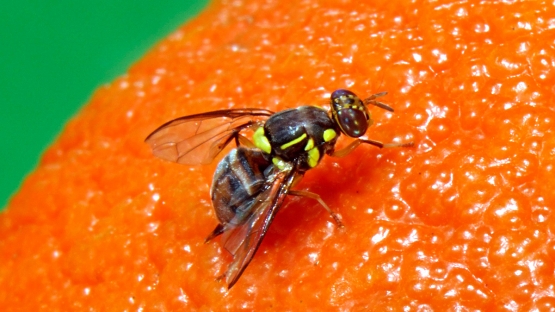A global research effort has finally resolved a major biosecurity issue: four of the world’s most destructive agricultural pests are actually one and the same.
For twenty years some of the world’s most damaging pest fruit flies have been almost impossible to distinguish from each other. The ability to identify pests is central to quarantine, international trade, pest management and basic research.
In 2009 a research effort coordinated by the Food and Agriculture Organization of the United Nations (FAO) and the International Atomic Energy Agency (IAEA) set out to definitively answer this question by resolving the differences, if any, between four of the most destructive fruit flies: the Oriental fruit fly, the Philippine fruit fly, the Invasive fruit fly and the Asian Papaya fruit fly. These species cause incalculable damage to horticultural industries and food security across Asia, Africa and the Pacific.
These studies conclusively demonstrate that the Oriental fruit fly, the Philippine fruit fly, the Invasive fruit fly, the Asian Papaya fruit fly are all the same biological species and have now been combined under the single name: Bactrocera dorsalis or the Oriental fruit fly.
Lead author, Dr. Mark Schutze from the Plant Biosecurity Cooperative Research Centre (PBCRC) and the Queensland University of Technology (QUT), believes that the integrated multidisciplinary nature of the project leaves little doubt that the species are identical. “More than 40 researchers from 20 countries examined evidence across a range of disciplines, using morphological, molecular, cytogenetic, behavioural and chemoecological data to present a compelling case for this taxonomic change”, he said.
“This outcome has major implications for global plant biosecurity, especially for developing countries in Africa and Asia”, said Dr. Schutze.
“For example, the Invasive (now Oriental) fruit fly has devastated African fruit production with crop losses exceeding 80 per cent, widespread trade restrictions with refusal of shipments into Asia, Europe and Japan, and significant economic and social impacts to farming communities,” Schutze further explained. Keeping exotic fruit flies out is a major concern for many countries, with the Oriental fruit fly being among the biggest threat to their plant biosecurity.
Confirming that the species are identical is also important in terms of applying the sterile insect technique (SIT), which is a form of insect birth control involving mass production of the target pest in industrial rearing facilities and low doses of radiation to sterilize male flies. The sterile males are released systematically by air on a sustained and area-wide basis over infested areas, where they mate with wild females who then, as a result, do not produce offspring. Integrating this technique with other pest management methods can effectively suppress wild pest populations in a more environmentally friendly way. Having demonstrated that the four fruit flies freely interbreed will allow for the use of sterile Oriental fruit fly males to reduce populations of the four pests.
Dr. Schutze further commented that “globally, accepting these four pests as a single species will lead to reduced barriers to international trade, improved pest management, facilitated transboundary international cooperation, more effective quarantine measures, the wider application of established post-harvest treatments, improved fundamental research and, most importantly, enhanced food security for some of the world’s poorest nations”.
The paper, Synonymization of Key Pest Species Within the Bactrocera Dorsalis Species Complex, was published in October 2014in the journal Systematic Entomology is the result of a collaboration between 33 research organizations in 20 countries supported by FAO and the IAEA.


